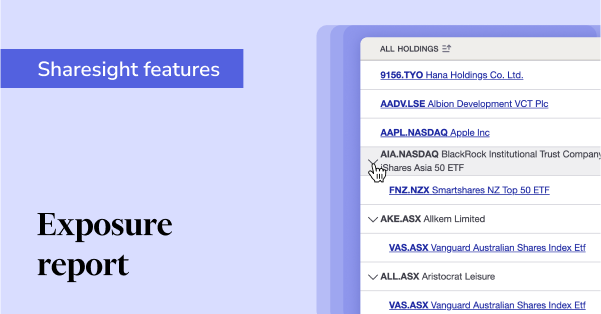Are Australian investors investing in Asia
Disclaimer: This article is for informational purposes only and does not constitute a product recommendation, or taxation or financial advice and should not be relied upon as such. Please consult with your financial adviser or accountant to obtain the correct advice for your situation.*
(This article was originally published the the Australian Shareholders' Association print magazine, Equity.)
Australians are renowned for being enthusiastic travellers, keen to discover the wonders of the world. Yet when it comes to investing, we tend to be homebodies.
The ASX has great investment opportunities, however, according to the International Monetary Fund, Australia represents just 1% of global GDP (based on purchasing power parity).
The number of investment opportunities that Australians might be missing out on as part of the remaining 99% is quite high.
Sharesight has users in over 90 countries around the world, but if we look solely at Australian users on paid plans to gain a better understanding of current trends, we can see a shift towards more internationally diverse portfolios over time. Looking at the period from 2010-2015, 12% of trades were placed directly on overseas exchanges, but since 2015 that figure jumped to 20%.

The Asian growth story has a long way to go
It’s often been said that if the 20th century was "the American century", the 21st century will be “the Asian century”.
According to the IMF, the Asia-Pacific (which excludes Australia and New Zealand) currently represents 46% of global GDP. That includes:
● China 19%
● India 8%
● Japan 4%
● Indonesia 3%
● South Korea 2%
The IMF expects the Asia-Pacific region to increase its share of GDP to 50% by 2024. This economic advancement coupled with growing populations in the regions could mean for a raft of interesting opportunities that investors could benefit from within the area.
Investors may be missing out on profitable Asian opportunities
Direct investment in Asian Markets
Sharesight’s data shows that while Australian users tend to be more internationally diversified than the average investor, only 4% of Australian paid users invest directly in Asian markets, compared to 25% in US markets and 8% in European/UK markets.
Just considering the possibilities of growth in the Asia-Pacific region, the opportunities that lie in wait for the canny investor are significant.
If we look just at the 4% who invest directly in Asia, we can see:
● 84% own companies listed on the Hong Kong Stock Exchange
● 19% own companies listed on the Tokyo Stock Exchange
● 17% own companies listed on the Singapore Exchange
If you’re wondering why the Hong Kong Stock Exchange is so popular, it’s because investors tend to use it to access Chinese growth opportunities. For example, about a third of our users that invest in Asia are part-owners of Tencent. Ping An Insurance (8%) and ICBC (4%) rank second and third.
Conversely, some investors may be underweight in Japanese stocks, considering the Tokyo Stock Exchange (TYO) is the third-largest stock exchange in the world by market cap.
If Australians investing in Asia were distributing their money evenly, we’d expect more of it to flow to Japan.
We’ve already discussed one advantage of investing overseas. There are two other advantages.
Geographic diversification: If Australia enters a recession but you’ve got investments in Asia and other parts of the world, this diversification will help shield your portfolio from potential losses.
Industry diversification: By investing overseas, you can increase your exposure to growth opportunities in sectors that are underweight in the ASX. Take technology: tech stocks represent about 25% of the value of America's S&P 500, yet only about 2% of the value of the Australian All Ords. If all those Australian banks and miners encounter problems, but you’ve got investments in tech and other sectors, your portfolio might still grow.
Two reasons to invest indirectly in Asia
Some might think this sounds great in theory, but that’s all it is, theoretical. After all, understanding overseas markets can be hard, given differences in language, culture, politics and economic conditions.
That’s one reason why some investors choose to invest directly in Australia but through ETFs overseas. Sharesight data shows that 14% of their Australian investors gain Asian exposure indirectly through ETFs, with the iShares Asia 50 ETF and iShares China Large-Cap ETFs being the most popular.
A second reason why some investors choose to invest indirectly in Asia is that it can be hard to find an Australian broker that gives you access to Asia. Some Australian brokers offer only local trading; others do provide overseas access, but only to the US and UK markets. So, it’s important when researching brokers to look for worldwide market support if you might consider investing directly in these markets in the future.
Another option might be to invest in ASX listed companies that generate a lot of their revenue in Asia, for example, a2 Milk, which is owned by 8% of Australian paid users. However, if you take that option, your geographic and industry diversification will be limited, which is why investing directly in Asian shares or ETFs might be a better choice.
Tackle your overseas investing with Sharesight
The final problem to tackle when investing directly overseas is ensuring that you accurately track your performance. The good news is that this can be done easily with Sharesight, which helps investors:
- Get the true picture of your investment performance, including the impact of brokerage fees, dividends, and capital gains with Sharesight’s annualised performance calculation methodology
- Sharesight automatically tracks your daily price & currency fluctuations, as well as handles corporate actions such as dividends and share splits
- Run powerful reports built for investors, including Performance, Portfolio Diversity, Contribution Analysis and Future Income (upcoming dividends)
- Plus run tax reports including Taxable Income (dividends/distributions), Capital Gains Tax (Australia and Canada), Traders Tax (Capital Gains for traders in NZ) and FIF foreign investment fund income reports (NZ)
Sign up for a FREE Sharesight account and get started tracking your investments today.
FURTHER READING

See what’s inside your ETFs with Sharesight’s exposure report
See inside your ETFs and get the full picture of your investment portfolio's composition with Sharesight's exposure report.

How KmacD Financial streamlines reporting and saves time with Sharesight
We talk to financial planning firm KmacD Financial about how the Sharesight-AdviserLogic integration helps them save time and streamline client reporting.

Sharesight product updates – November 2023
The focus over the past month has been on implementing additional feature ideas relating to our new (beta) exposure report.